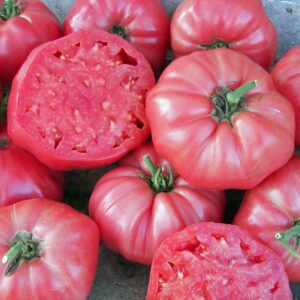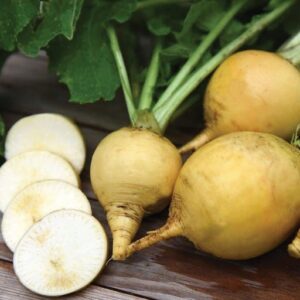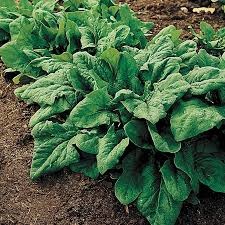Shanghai bok Choy variety of Chinese cabbage
Description of Shanghai bok Choy variety of Chinese cabbage.
Shanghai bok choy, also known as baby bok choy, is a smaller and more delicate variety of bok choy. Here’s a description:
Appearance: Shanghai bok choy has small, tender leaves with thin, pale green stalks. The leaves are smooth and slightly glossy, forming a compact cluster around the base of the plant. Compared to regular bok choy, Shanghai bok choy is smaller in size and has a more delicate appearance.
Flavor: It has a mild, slightly sweet flavor with a hint of peppery undertones, similar to regular bok choy. Despite its smaller size, Shanghai bok choy offers the same pleasant taste and versatility in cooking.
Texture: The leaves of Shanghai bok choy are tender and crisp, while the stalks are crunchy and succulent. The texture is similar to regular bok choy, making it suitable for a variety of culinary applications.
Culinary Uses: Shanghai bok choy is commonly used in Asian cuisine, particularly in stir-fries, soups, and steamed dishes. Its small size and delicate texture make it ideal for quick cooking methods. Shanghai bok choy can also be eaten raw in salads or used as a garnish.
Nutritional Benefits: Like regular bok choy, Shanghai bok choy is low in calories and rich in vitamins and minerals, including vitamins A, C, and K, as well as folate, potassium, and calcium. It’s also high in fiber and antioxidants, making it a nutritious addition to your diet.
Storage: Shanghai bok choy can be stored in the refrigerator for up to a week. To extend its shelf life, wrap the bok choy in a damp paper towel and place it in a plastic bag or vegetable crisper drawer.
Overall, Shanghai bok choy is prized for its mild flavor, crunchy texture, and versatility in cooking, making it a beloved ingredient in many Asian dishes and beyond.
Planting instructions for Shanghai bok Choy variety of Chinese Cabbage.
To plant Shanghai bok choy, follow these steps:
- Location and Soil Preparation: Choose a location with partial shade to full sun and well-drained soil. Bok choy prefers loose, fertile soil with a pH level between 6.0 and 7.5. Incorporate organic matter like compost into the soil before planting to improve its texture and fertility.
- Sowing Seeds: Directly sow bok choy seeds in the garden bed, spacing them about 6 inches apart in rows that are 12-18 inches apart. Plant the seeds ¼ to ½ inch deep and cover lightly with soil. Keep the soil consistently moist until the seeds germinate, which usually takes 7-14 days.
- Watering: Bok choy requires regular watering to keep the soil evenly moist. Water deeply when the top inch of soil feels dry, and avoid letting the soil dry out completely. Mulching around the plants can help retain moisture and regulate soil temperature.
- Thinning: Once the seedlings have developed their first true leaves, thin them to maintain proper spacing. Leave the strongest seedlings, spacing them about 6-8 inches apart.
- Fertilizing: Fertilize bok choy plants with a balanced fertilizer about 3-4 weeks after planting, following the instructions on the fertilizer package. Avoid over-fertilizing, as this can lead to excessive foliage growth at the expense of forming heads.
- Pest and Disease Management: Keep an eye out for common pests such as aphids, cabbage worms, and flea beetles, and manage them promptly using organic methods like handpicking or spraying with neem oil. Ensure good air circulation around the plants to prevent fungal diseases.
- Harvesting: Shanghai bok choy is typically ready for harvest 45-60 days after planting, depending on the variety and growing conditions. Harvest the entire plant by cutting it at the base when the leaves are crisp and firm. Enjoy fresh in salads, stir-fries, soups, or steamed dishes.
Description of Shanghai bok Choy variety of Chinese cabbage.
Shanghai bok choy, also known as baby bok choy, is a smaller and more delicate variety of bok choy. Here’s a description:
Appearance: Shanghai bok choy has small, tender leaves with thin, pale green stalks. The leaves are smooth and slightly glossy, forming a compact cluster around the base of the plant. Compared to regular bok choy, Shanghai bok choy is smaller in size and has a more delicate appearance.
Flavor: It has a mild, slightly sweet flavor with a hint of peppery undertones, similar to regular bok choy. Despite its smaller size, Shanghai bok choy offers the same pleasant taste and versatility in cooking.
Texture: The leaves of Shanghai bok choy are tender and crisp, while the stalks are crunchy and succulent. The texture is similar to regular bok choy, making it suitable for a variety of culinary applications.
Culinary Uses: Shanghai bok choy is commonly used in Asian cuisine, particularly in stir-fries, soups, and steamed dishes. Its small size and delicate texture make it ideal for quick cooking methods. Shanghai bok choy can also be eaten raw in salads or used as a garnish.
Nutritional Benefits: Like regular bok choy, Shanghai bok choy is low in calories and rich in vitamins and minerals, including vitamins A, C, and K, as well as folate, potassium, and calcium. It’s also high in fiber and antioxidants, making it a nutritious addition to your diet.
Storage: Shanghai bok choy can be stored in the refrigerator for up to a week. To extend its shelf life, wrap the bok choy in a damp paper towel and place it in a plastic bag or vegetable crisper drawer.
Overall, Shanghai bok choy is prized for its mild flavor, crunchy texture, and versatility in cooking, making it a beloved ingredient in many Asian dishes and beyond.
Planting instructions for Shanghai bok Choy variety of Chinese Cabbage.
To plant Shanghai bok choy, follow these steps:
- Location and Soil Preparation: Choose a location with partial shade to full sun and well-drained soil. Bok choy prefers loose, fertile soil with a pH level between 6.0 and 7.5. Incorporate organic matter like compost into the soil before planting to improve its texture and fertility.
- Sowing Seeds: Directly sow bok choy seeds in the garden bed, spacing them about 6 inches apart in rows that are 12-18 inches apart. Plant the seeds ¼ to ½ inch deep and cover lightly with soil. Keep the soil consistently moist until the seeds germinate, which usually takes 7-14 days.
- Watering: Bok choy requires regular watering to keep the soil evenly moist. Water deeply when the top inch of soil feels dry, and avoid letting the soil dry out completely. Mulching around the plants can help retain moisture and regulate soil temperature.
- Thinning: Once the seedlings have developed their first true leaves, thin them to maintain proper spacing. Leave the strongest seedlings, spacing them about 6-8 inches apart.
- Fertilizing: Fertilize bok choy plants with a balanced fertilizer about 3-4 weeks after planting, following the instructions on the fertilizer package. Avoid over-fertilizing, as this can lead to excessive foliage growth at the expense of forming heads.
- Pest and Disease Management: Keep an eye out for common pests such as aphids, cabbage worms, and flea beetles, and manage them promptly using organic methods like handpicking or spraying with neem oil. Ensure good air circulation around the plants to prevent fungal diseases.
- Harvesting: Shanghai bok choy is typically ready for harvest 45-60 days after planting, depending on the variety and growing conditions. Harvest the entire plant by cutting it at the base when the leaves are crisp and firm. Enjoy fresh in salads, stir-fries, soups, or steamed dishes.





